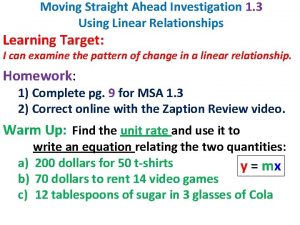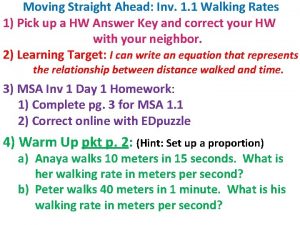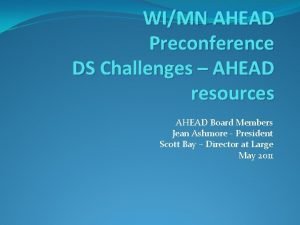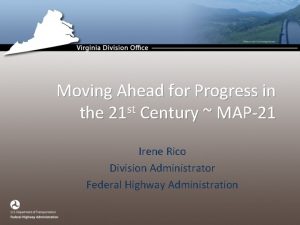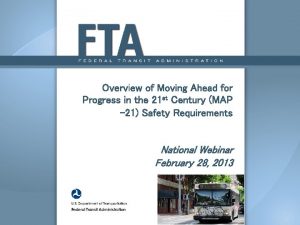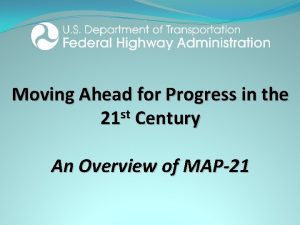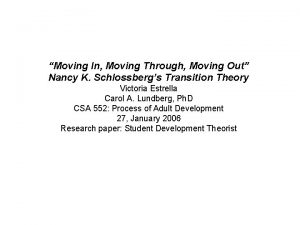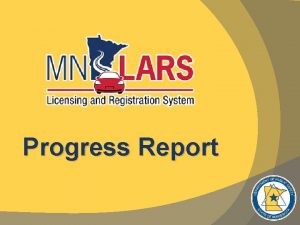Moving Ahead for Progress in the 21 st















- Slides: 15

Moving Ahead for Progress in the 21 st Century Act MAP-21 Jason Buys Financial Manager Federal Highway Administration Virginia Division

Presentation Outline • • • Key highlights Funding levels Innovative financing and tolling Performance Management Accelerated project delivery Accelerating the environmental process

Key Highlights • America responds to Surface Transportation needs • Strong bipartisan support for passage in Congress – House 372 -52; Senate 74 -19 • Key provisions – – – – Stable funding through end of FY 2014 Program consolidation A state-centric bill that meets many of AASHTO’s goals Creates jobs and supports economic growth Accelerates project delivery and promotes innovation Establishes a performance-based Federal Program Supports the Department’s aggressive safety agenda

Funding Levels Funding ensures two years of solvency for the Highway Trust Fund Substantial programmatic consolidation Most discretionary programs eliminated No earmarks

$37. 7 billion/year in formula funding National Highway Performance Program, 21, 8 Surface Transportation, 10 HSIP $2. 2 Railway-Highway Crossing $0. 2 CMAQ $2. 2 Transportation Alternatives $0. 8 Metro Planning, $0. 3

National Highway Performance Program ($21. 8 B) • Funds an enhanced National Highway System, combining functions of existing NHS, IM and Bridge Programs • Enhanced NHS includes existing NHS, all principal arterials, STRAHNET, and intermodal connectors • Requires an asset management plan • States set targets for conditions and performance • Min. standards for Interstate and bridge conditions – DOT to set minimum standards for interstate pavement condition – Law sets standard for NHS bridges – no more than 10% of deck area may be structurally deficient

Surface Transportation Program ($10. 0 B) • Continued flexible funding for Federal-aid highways, plus safety and bridges on any public road • Eligibility for transportation enhancements, rec trails, ferry boats, consolidated border infrastructure program, truck parking facilities, and safe routs to schools (no set-aside) • 50% of funds subject to sub-allocation based on population • Rural provisions enhanced – Rural planning organizations if any must be consulted – Up to 15% of rural sub-allocation may be spent on minor collectors

Highway safety Improvement Program ($2. 2 B) • Doubles size of existing program • Maintains current structure; adds requirement for regular update of the strategic highway safety plan • Keeps set aside ($220 M/year) for rail-highway grade crossings • No high risk rural roads set aside unless safety statistics worsen • Secretary to establish measures and States to set targets for number of injuries and fatalities (and number per VMT) • Strengthens link between HSIP and NHTSA programs

Congestion Mitigation & Air Quality Improvement Program ($2. 2 B) • Continues the current program with changes • Performance plans for large TMAs – To include air quality and congestion measures • States with PM 2. 5 areas must use a portion of their funds to reduce PM 2. 5 • Some expanded authority to use funds for transit operations • Explicit support for installation of facilities serving electric or natural gas-fueled vehicles • CMAQ outcomes assessment study required

Transportation Alternatives (TA) ($814 M) • Incorporates eligibilities from many current programs – Most (but not all) formerly TE-eligible activities – Recreational trails program – Safe Routes to Schools program – Planning, designing, or constructing roadways within the TOW of former Interstate or divided highways • Similar funding level to TEs under SAFETEA-LU

Innovative Finance and Tolling • Expanded and enhanced TIFIA program – – Lending capacity expanded from ~$1 B/yr to up to $10 B/yr Applications throughout the year Provides for TIFIA participation in project costs from 33% to 49% 10% set aside for rural projects: increased eligibility, lower interest rates • Revisions to toll authorities – Mainstreams tolling/pricing of new capacity, including Interstate (but generally requires current level of free capacity to remain unchanged) – In most cases, removes the requirement for USDOT/State toll agreements – Extends toll pilots for value pricing and Interstate reconstruction

Performance management MAP-21 identifies national goal areas USDOT establishes measures, with input States set targets State and metro plans describe how the organization will use program and project selection to help achieve targets • States report to USDOT on progress toward targets (within 4 years of enactment, then biennially) • Reports typically lead to corrective actions (not sanctions) • Consequences if condition of NHS falls below thresholds • •

Accelerating project delivery • Any State can choose to assume specific CE designations in FHWA NEPA regulations • Use of construction manager/general contractor (CMGC) method of contracting • Accelerated completion of complex projects (4 years) when States request technical assistance • Allows for lump sum payment for purchase of ROW

Accelerating the environmental process • Environmental review process streamlining – – – FEIS and ROD combined in certain conditions Allows for the use of planning products in the NEPA process Deadlines for issue resolution, with penalties for agencies Programmatic mitigation plans Reduced statute of limitations on claims to 150 days from 180. • Expanded authority for categorical exclusions – – Multi-modal projects Projects to repair roads damaged in declared emergency Projects within existing operational right-of-way Projects receiving $5 M or less of federal funding (or total cost under $30 M with less than 15% Federal share) can be considered as CE

Questions? Jason Buys Jason. buys@dot. gov 541 -279 -8910
 Allstate foundation moving ahead grants
Allstate foundation moving ahead grants Moving straight ahead investigation 1
Moving straight ahead investigation 1 Moving straight ahead answer key
Moving straight ahead answer key Physical progress and financial progress
Physical progress and financial progress Elektronik för barn
Elektronik för barn Borra hål för knoppar
Borra hål för knoppar Anatomi organ reproduksi
Anatomi organ reproduksi Smärtskolan kunskap för livet
Smärtskolan kunskap för livet Bris för vuxna
Bris för vuxna Vad är ett minoritetsspråk
Vad är ett minoritetsspråk Typiska drag för en novell
Typiska drag för en novell Frgar
Frgar Magnetsjukhus
Magnetsjukhus Indikation för kejsarsnitt på moderns önskan
Indikation för kejsarsnitt på moderns önskan Toppslätskivling effekt
Toppslätskivling effekt Redogör för vad psykologi är
Redogör för vad psykologi är

